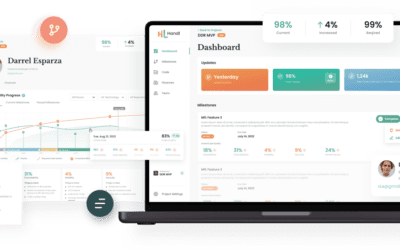
The other day I read that in a sample of 10,000 startups, 65% failed due to “people issues”.
I think that’s bullshit.
All startup teams are made of people. And people are flawed. They have good days and bad days. You’ll never build a team where this isn’t true.
That means “people issues” is an inevitability not an unknown. They’re something we can factor into our business operations.
In truth, startup teams don’t fail because of the “people issues”, they fail due to our inability to manage “people issues”
Startups sink because there are no processes in place. Leadership dictates instead of delegates so people never take initiative. There aren’t goals or metrics to hold team members accountable.
My point is, that without a clear and continually refined process, people will make ill-advised decisions; their flaws will run rampant. And as the founder, that’s on you, not your people.
In my experience, a high-performance startup that has a defined process with clear decision making structures can limit people’s bad decisions (flaws) and optimize towards good decisions (strengths). Structurally, it’s a process that:
- Brings teams together around your central purpose.
- Keeps everyone accountable with solid metrics.
- Gives everyone the tools to do their best work.
And when you put these structures in place, it limits your exposure to the negative effects of people issues. So here’s exactly how to build them…
Lead with purpose
In 2008 three guys wanted a better way to share code so they started a weekend project. Today they’re the largest code host in the world.
That’s GitHub’s story. But it’s also an outstanding lesson in team-building.
Because as GitHub scaled the entire business and team remained focussed around that one central purpose: making code easier to share. And that vision was communicated to everyone.

A single purpose has been baked into every successful startup team I’ve ever worked with. Every person — the tech, the creative, the sales, the marketing — is rallied around a purpose, a vision, a problem you’re solving.
(Psst. I’ve got some ideas on how to find your purpose here.)
And it’s because communicating your purpose informs your startup’s culture. It means everyone’s on the same page so feedback becomes less about personal ideas and more about what works in service of your end-goal. Things become about the best way to do things — not the fastest or easiest. Teams communicate better, know what they’re aiming for, and work in the same direction to get there.
To realise this, everyone needs to understand your purpose and how they fit into that purpose. And that’s on you to deliver a clear and consistent purpose from the get-go and throughout your product’s lifecycle.
How to lead with purpose
1. Document and share your purpose
That means defining what your purpose, why it’s important, who it’s for, why you’re doing it, etc., etc., and then thoroughly documenting it and share with your team. Don’t get hung up on how you document it. Just document it and then make it available to everyone — heck, a Google doc that anyone can access at any time will do. Whatever works from your toolset.
2. Onboard with ruthless precision
Your onboarding process needs to make that documented purpose entirely clear to new employees and external teams.
More than that, you need to explain exactly how each new employee, team, or freelancer, or external team fits into this vision. Take the time to explain it to them, because the more they understand what you’re trying to achieve, the better they’re going to deliver.
3. Course-correct your purpose in real-time
Continually reinforcing your purpose is critical. Think of it like flying a spaceship to Mars. If you notice your coordinates are off by two degrees at the beginning, it’s only a tiny adjustment to get back on track. But if you don’t adjust until two days before arrival, you’ve probably missed the entire planet.
Same goes for your purpose. If you’re not checking in regularly, your teams might completely miss the point. That means going back to your documented purpose in step one and reworking it as your business evolves.
It also means checking in with your team in a structured way:
- Management one-on-ones
- Daily standups
- Weekly catch-ups
- Monthly all-hands
Find the check-in method that works for you and your team. The point is to talk freely and allow everyone to have a voice. The best teams are collaborative and don’t work on top-down orders.
And remember, these conversations aren’t just about improving the business. It’s about building cohesion in your team, listening to them, and being a good person. It’s hard to get buy-in from a team or for an idea when you don’t like the people around you.
But to know exactly when teams are deviating from your purpose, why, and how to fix it, you need a way of measuring their effectiveness. And that’s where metrics come in…
Goals with metrics keep your team honest
I like to think of goals and metrics like this: Goals create targets for your teams to aim for and metrics measure whether they hit those targets.

They work off each other. There are no goals without accountability and there is no accountability without metrics. Without one, the other is ineffective. But when you combine them, you get a formula that pushes your team to improve.
Setting goals and measuring your team’s performance gives you and them insight into how their work impacts your business. It makes them accountable for results, not just getting the job done. It gives you visibility into how engaged and effective they are — where they can learn and grow. It tells you how to better manage your team.
Now, this doesn’t mean you need to know the ins and outs of the product team’s code line by line, the marketing team’s ad spend to the cent. It means…
…understanding whether they’re delivering results or just producing.
…knowing if your team is making progress.
…making your team is working towards a better product for your customer.
…seeing your customer love the product you’ve built.
But for most startups, it’s about figuring out what to measure first. And that’s no easy feat.
How to do metrics the right way
1. Great metrics are tied to business objectives
Choose metrics that clearly indicate where you are now in relation to where you want to go.
For instance, say you’re an established startup. Your goal might be to improve the length of time each customer stays with your product. A metric you could set to reach this goal might be for your support team to reduce churn by 1%. Notice how this metric is directly related to a business outcome
Faulty metrics (vanity metrics), on the other hand, are often decoupled from concrete business outcomes. A goal like gaining 10,000 LinkedIn comments doesn’t measure the impact on your business, and only your Linkedin footprint. An effective goal to measure the effectiveness of Linkedin comments would be to measure an increase in signups, trials, or web traffic.
The point is, be wise about the metrics you choose and make sure they’re tied to measurable business outcomes.
It’s also worth noting that metrics aren’t one-size-fits-all.
2. Great metrics benchmark, then measure progress
As a new startup historic data isn’t really an option so knowing what metrics to target is kinda confusing — especially if the business model has not been fully defined or implemented yet.
That means you need to start with benchmarks. Select the metrics you think are right for you and start measuring. Your first measurement should act as a benchmark for where you’re at. Once you’ve captured that initial benchmark, you can start measuring against it to gauge whether things are improving.
That way you can understand where your team is performing and where they can improve.
Keep in mind, choosing your metrics is iterative. It’s hard to get it right the first time — very few do. The most successful founders know metrics evolve and tweak them to match their objectives.
One final note, if there’s data available to you, capture it and store everything. Even if it’s not useful today it might come in handy for insights or a report down the line.
3. Great metrics diagnose problems and drive change
When you have the right metrics in place for your team, everything anyone does has an outcome. Say your churn rate increases, what changes have we made to the product, the marketing, the sales process? Metrics raise questions, diagnose problems, and inform the best next steps for your team.
Let data drive your decisions. This helps your team figure out their next goals and actions.
In short, each startup will need to focus on its own specific success indicators. As long as each metric is defined correctly and measured against, you’ll be on the right track.
But for your teams to hit those metrics, they need to be equipped with the right tools to do so…
Give your teams the right tools for the job

In a post-COVID world, teamwork has changed for, what I believe is, the better.
Remember the old model:
- A team gets together in a meeting room (or Zoom) to solve a problem.
- The loudest people in the room blurt out their ideas.
- Ideas are assessed on confidence and volume, not validity or quality.
- The loudest idea wins, not the best idea.
Here’s how modern high-performing team model works:
- Rather than a meeting, everyone comes together on a tool like Slack, Teams, Docs, Figma, etc. (You pick the stack that works for you.)
- The collaborative nature of these tools gives everyone an equal voice (at an equal volume).
- It makes the whole team stop and consider what everyone else is saying, then respond.
- This model selects for the best idea, not the loudest.
You see, collaboration tools are changing the way we work for the better. And as a startup with a shorter runway and limited resources, getting to the best ideas faster than the competition can be one of your biggest advantages. It’s why embracing collaboration tools and working in new, more effective ways is so important.
Process is the engine of high-performance
Whether you’re building a full-time team or bringing in an external one, putting in place a process that communicates your purpose, measures progress, and empowers teams to do their best work will set you up to thrive going forward.

So when one of your people does have a bad day or week or month (because people do!), you’ve got a process that manages the “people issues”– you understand why it’s happening, what impact it’s happening, and how to manage it.
And when everything’s going good, every person is working towards your startup vision in lockstep.




